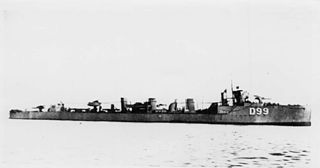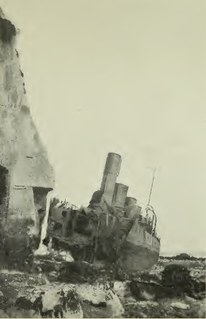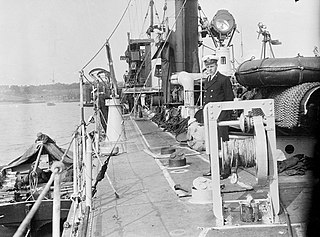Construction and design
HMS Mohawk was ordered from J. Samuel White under the 1905–06 shipbuilding programme for the Royal Navy, one of five Tribal class destroyers ordered under that programme. [1] The Tribals derived from a requirement by the First Sea Lord "Jackie" Fisher, for a steam turbine powered, oil-fueled destroyer capable of at least 33 knots (61 km/h; 38 mph). Armament was specified as three 12 pounder (3 inch, 76 mm) 12 cwt guns [lower-alpha 1] and two 18 inch (450 mm) torpedo tubes. [2] [3]
While the Admiralty laid down the basic requirements, the details of the design of individual ships was left to the builders, although the builder's designs did need to be approved by the Director of Naval Construction before orders were placed. This meant that individual ships of the class differed significantly from each other. [2] [3] White's design featured a flush deck and a turtleback forecastle. [4] Mohawk was 276 feet 0 inches (84.12 m) long overall and 270 feet 0 inches (82.30 m) between perpendiculars, with a beam of 25 feet 0 inches (7.62 m) and a draught of 8 feet 11 inches (2.72 m). Displacement was 865 long tons (879 t) normal and 950 long tons (970 t) deep load. [5] Six White-Foster boilers fed steam to turbines driving three propeller shafts. The main high-pressure turbine drove the centre shaft, with the outer shafts being fitted with low-pressure turbines, together with cruise and astern turbines. Four funnels were fitted. [1] [6] The machinery was rated at 14,500 shaft horsepower (10,800 kW). The ship had a complement of 74 officers and men. [5]
Mohawk was laid down at White's Isle of Wight shipyard on 1 May 1906 and launched on 15 March 1907. [7] Mohawk's sea trials showed that she was fast, reaching a speed of 34.916 knots (64.664 km/h; 40.181 mph), well in excess of the required 33 knots (61 km/h; 38 mph). [1] Seakeeping was poor, however, with the ship rolling badly, and Mohawk had to be rebuilt with a raised forecastle to give acceptable seakeeping. [8] [9] Mohawk was completed in June 1908. [7] It had been realised during construction that the armament of the Tribals was too light, so it was decided to strengthen the armament of the first five ships, including Mohawk, by adding another two 12-pounder guns. This was done to Mohawk following acceptance by the Royal Navy. [10]
Service
On commissioning, Mohawk joined the other ships of her class in the 1st Destroyer Flotilla of the Home Fleet. She remained part of the 1st Flotilla until 1913, when she transferred to the 4th Destroyer Flotilla, [11] based at Portsmouth. [12] In October that year, the Tribals were officially designated the F class, and as such the letter "F" was painted on the bows of the class. [8] [13] In February 1914, the Tribals (including Mohawk), whose range was too short for effective open sea operations, were sent to Dover, forming the 6th Destroyer Flotilla. [8] [11]
On the outbreak of the First World War the 6th Flotilla formed the basis of the Dover Patrol. [14] An early duty was escorting the ships carrying the British Expeditionary Force to France. A German submarine attempted to attack Mohawk on 6 October, but the destroyer and the ships she was escorting were unharmed. [15] On 1 June 1915 Mohawk encountered a minefield laid by SM UC-11 at the southern entrance to the Downs. Several mines were spotted close to Mohawk which struck one. Five of Mohawk's crew were killed, and Mohawk was towed back to Dover with her decks almost awash. [16] [17] [18]
On the night of 26/27 October 1916, German torpedo boats of their Flanders Flotilla carried out a large scale raid into the English Channel, hoping to attack the drifters watching the anti-submarine nets of the Dover Barrage, and to sink Allied shipping in the Channel. Mohawk was one of six Tribal-class destroyers waiting at readiness in Dover harbour, and when the Germans attacked the drifters and sank the supporting destroyer HMS Flirt, they were ordered to intervene. The destroyers split up as they left Dover harbour, with Viking leading Mohawk and Tartar from the Western entrance to the port, while the other three destroyers (Nubian, Amazon and Cossack) left by the other entrance and failed to join up with Viking's group. Nubian and Amazon separately ran into the German 17th Half Flotilla, with Nubian first being badly damaged by a torpedo and Amazon then heavily hit by German shells. The group led by Viking then encountered another German formation, the 18th Half Flotilla. German shells killed four aboard Mohawk and caused her steering to jam, blocking the course of Viking when she attempted to pursue the German torpedo boats, that escaped unharmed. [19] [20]
Mohawk remained with the 6th Flotilla until 3 October 1917, [21] joining the 10th Submarine Flotilla. [8] Mohawk remained part of the 10th Submarine Flotilla at the end of the war on 11 November 1918. [22] She was sold for scrap on 27 May 1919. [23]

The Beagle class was a class of sixteen destroyers of the Royal Navy, all ordered under the 1908-1909 programme and launched in 1909 and 1910. The Beagles served during World War I, particularly during the Dardanelles Campaign of 1915.

The first HMS Zulu was a Tribal class destroyer launched 16 September 1909 at Hawthorn Leslie Shipyard and commissioned in March 1910. She was mined during the First World War, on 27 October 1916 off Dover in a minefield lain by the Imperial German submarine UC-1. Her stern was blown off and sank, but the forward section remained afloat. It was towed into port and attached to the stern of Nubian, which had been torpedoed, to form a new destroyer named HMS Zubian.

HMS Zubian was a First World War Royal Navy Tribal-class destroyer constructed from the forward end of HMS Zulu and the rear and mid sections of HMS Nubian. These two destroyers had been badly damaged in late 1916, and rather than scrapping both hulls at the height of World War I, the Admiralty ordered that they be rebuilt as the composite Zubian and put back into service. She was commissioned into the fleet in June 1917. The name Zubian is a portmanteau of the names of the original ships.

HMS Nubian was a Royal Navy Tribal-class destroyer. She was launched in 1909 and torpedoed in 1916. With her bow blown off, the wreck was used to create a new ship by joining the bow of another destroyer of the same class, HMS Zulu. The resulting ship was given the portmanteau name HMS Zubian. She went on to sink the U-boat SM UC-50 in 1918 and was scrapped in 1919.

HMS Ghurka was a Tribal-class destroyer built in 1907 for the Royal Navy. She served as part of the Dover Patrol during the First World War, playing a part in the sinking of the German submarine U-8 in 1915, and was sunk by a German mine in 1917.

HMS Laforey was the lead ship of her class of destroyer built for the Royal Navy. Launched a year before the First World War began, she was attached to the Dover Patrol. Laforey saw action in several engagements with German torpedo boats, including the Battle off Noordhinder Bank and the action of 17 March 1917. Laforey was sunk in 1917 by a British mine after escorting several freighters to France. She was named for Francis Laforey, captain of HMS Spartiate at the Battle of Trafalgar in 1805.

HMS Afridi was a Tribal-class destroyer of the Royal Navy launched in 1907 and sold for scrap in 1919. During the First World War she served in the North Sea and the English Channel with the 6th Destroyer Flotilla and as part of the Dover Patrol.

HMS Viking was a Tribal-class destroyer of the Royal Navy launched in 1909 and sold for scrap in 1919. She was the only destroyer ever to have six funnels.

HMS Cossack was a Tribal-class destroyer of the Royal Navy launched in 1907 and sold in 1919.

HMS Tartar was a Tribal-class destroyer of the Royal Navy launched in 1907 and sold in 1921. During the First World War she served in the North Sea and the English Channel with the 6th Destroyer Flotilla.
HMS TB 12 was a Cricket-class coastal destroyer or torpedo-boat of the British Royal Navy. TB 12 was built by the shipbuilder Yarrow from 1905 to 1907. She was used for local patrol duties in the First World War and was sunk by a German mine in the North Sea on 10 June 1915.
HMS TB 11 was a Cricket-class coastal destroyer or torpedo-boat of the British Royal Navy. TB 11 was built by the shipbuilder Yarrow from 1905 to 1907. She was used for local patrol duties in the First World War and was sunk by a German mine in the North Sea on 7 March 1916.
HMS TB 9 was a Cricket-class coastal destroyer or torpedo-boat of the British Royal Navy. TB 9 was built by the shipbuilder Thornycroft from 1905 to 1907. She was used for local patrol duties in the First World War and was sunk following a collision in the North Sea on 26 July 1916.
HMS Lark was a Laforey-class destroyer of the British Royal Navy. The Laforey class was the class of destroyers ordered under the Royal Navy's 1912–1913 construction programme, which were armed with three 4-inch (102 mm) guns and four torpedo tubes and were capable of 29 knots. The ship, which was originally to be named Haughty but was renamed before launch, was built by the Scottish shipbuilder Yarrow between 1912 and 1913.

HMS Laurel was a Laforey-class destroyer which served with the Royal Navy. Launched on 6 May 1913 as HMS Redgauntlet, the ship was renamed on 30 September under an Admiralty order to become one of the first alphabetical class destroyers. On commissioning, the vessel joined the 3rd Destroyer Flotilla and operated as part of the Harwich Force during the First World War. During Battle of Heligoland Bight, Laurel led a flotilla that pursued German torpedo boats, engaging with G194 and G196, and was damaged in action with the cruiser Mainz. The vessel also played a minor role in the Battles of Dogger Bank, Dover Strait and Jutland. With the cessation of hostilities, the ship was placed in reserve and scrapped on 1 November 1921.

HMS Liberty was a Laforey-class destroyer that served with the Royal Navy during the First World War. Launched on 15 September 1913 as HMS Rosalind, the ship was renamed on 30 September under an Admiralty order to become one of the first alphabetical class destroyers. On commissioning, the vessel joined the Third Destroyer Flotilla and operated as part of the Harwich Force. During Battle of Heligoland Bight, Liberty engaged with the German torpedo boats G194 and G196, and scored two hits on the cruiser Mainz. On 8 February 1917, the destroyer rammed and sank the German submarine UC-46. The vessel also played a minor role in the battles of Dogger Bank, Dover Strait and Jutland, as well as acting as a convoy escort and patrolling the Dover Barrage. With the cessation of hostilities, the ship was placed in reserve and sold to be broken up on 5 November 1921.
HMS TB 23 was a Cricket-class coastal destroyer or torpedo-boat of the British Royal Navy. TB 23 was built by the shipbuilder Yarrow from 1907 to 1908. She was used for local patrol duties in the First World War and was sold for scrap in 1921.

HMS Narwhal was a Admiralty M-class destroyer which served with the Royal Navy during the First World War. The M class were an improvement on the preceding L class, capable of higher speed. Launched on 30 December 1915, the vessel fought in the Battle of Jutland between 31 May and 1 June 1916 and subsequently served in anti-submarine and escort duties based at Cobh in Ireland. During February 1917, the destroyer rescued the crew of the Q-ship Farnborough, which had sunk and been sunk by the German submarine SM U-83, and rescued the armed merchantman Cameronia from SM U-50, The destroyer was transferred to Devonport during 1918 and, after the end of the war, was broken up there in 1920 after suffering a fatal collision the year before.

HMS Lawford was a Laforey-class destroyer of the British Royal Navy. The Laforey class was the class of destroyers ordered under the Royal Navy's 1912–1913 construction programme, which were armed with three 4-inch (102 mm) guns and four torpedo tubes and were capable of 29 knots. The ship, which was originally to be named Ivanhoe but was renamed before launch, was built by the Scottish shipbuilder Fairfields between 1912 and 1914.
HMS TB 4 was a Cricket-class coastal destroyer or torpedo-boat of the British Royal Navy. TB 4 was built by the shipbuilder J S White from 1905 to 1907. She served in the Dover Patrol in the First World War and survived the war. She ran aground on the way to be scrapped on 11 January 1921 and was broken up in situ.














